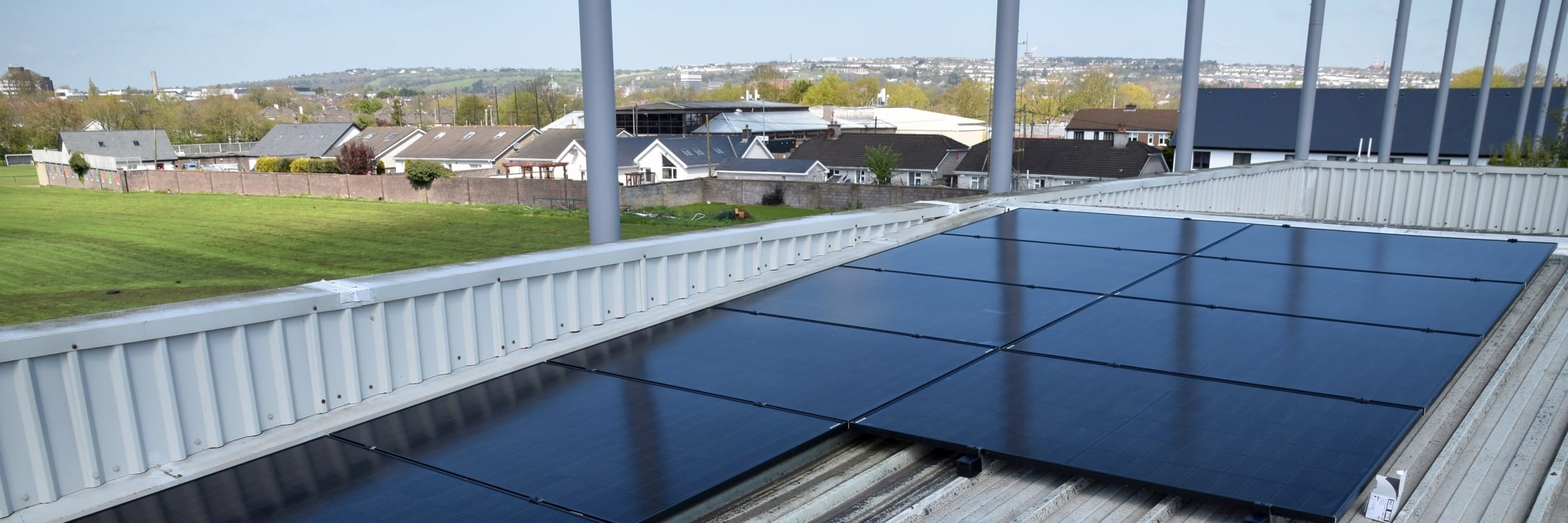
Commercial solar panel calculator
A quick and simple solar calculator to give you a rough guide to area of panels needed, potential solar electricity generation and SEAI grant values.

A quick and simple solar calculator to give you a rough guide to area of panels needed, potential solar electricity generation and SEAI grant values.
We've prefilled this with a 50-panel (22 kWp) array to get you started (which would cover 105.8 m²). We've also popped in all the other standard numbers for commercial solar in Ireland.
The grant value only depending on the number & power of the panels. If you'd just like the NDMG scheme grant just adjust the panel value and it will tell you how much the SEAI would contribute towards your solar panels.
Adjust any figures you like and see the outputs adjust automatically.
Use the Solar Calculator to update these totals | |
Your figures: | |
| NDMG Scheme Grant Value: | |
| Panel array area: | |
| Total solar array kWp: | |
| Annual units generated: | |
| Annual CO2 emissions saved: | |
A quick disclaimer - we have purposely made this very simple & basic to give you fast ballpark numbers for electricity production & CO2 saved. The tools we use ourselves when we are producing solar quotes are much more complicated and take many more factors into account. For example, we've not worried about shading, inverter losses and many other factors.
That said this tool should give you a reasonable indication of if solar might be worth considering for your business. It does take the major factors of things like the roof slope, panel orientation, which county you are in (including local weather patterns) and alike when calculating the likely electricity generation from pv solar panels.
If solar seems in the right ballpark for your company, and you'd like a more accurate calculations, just get in touch and we'd be more than happy to do far more detailed calculations for you to give you a more accurate idea of what's possible.
The Strategic Banking Corporation of Ireland (SBCI) has launched the €150m Energy Efficiency Loan Scheme to help small and medium-sized enterprises (SMEs) reduce their energy costs and carbon emissions. This finance scheme offers loans for SMEs planning to invest in solar panels, heat pumps, LED lighting, and other energy-saving technology.
Businesses using the new Energy Efficiency Loan Scheme will benefit from easier access and reduced interest rates. Fixed rates of 4.79% are currently available on loans ranging from €10,000 to €150,000, over terms of up to 10-years. There are no personal guarantees required, either.
More about the Energy Efficiency Loan SchemeGet in touch to see what going solar could save your business. It's quick, easy, and free.
The first step in the process. We gather as much information as possible to make an informed assessment. We will request your annual site electrical data and determine your roof space and what is achievable in terms of roof area and roof type.
As soon as we have analysed the data and determined the correct system size we will present you with a preliminary proposal.
A preliminary proposal is sufficiently detailed enough to allow us to determine if a solar array is the right solution for your business. We want what is right for you. So this is an important step before either party commits too much time or resource on something that may not progress past the concept stage in the short/medium-term.
If our proposal is within the ballpark, the next step is to meet you on-site to measure and understand the different variables on-site.
Assuming all goes well we will return to you a formal proposal. This proposal will be more detailed than the preliminary proposal and give an indication of what the installation will look like and if there will be interruptions to site operations.
This is final decision point for you. Only after this stage are to committed to anything Once you have agreed to move forward with your project we begin the process for the ESB Networks connection application and planning permission.
We'll guide you through this process. It is fast and straightforwards process, and the SEAI often reply within the same day with your approval. More about SEAI solar grants for business / non-domestic.
We look after all the paperwork here for you. The timeline depends on your system size. For smaller systems we do an NC6 form, and approval normally comes back in 20 working days. For larger systems then it's an NC7 form, and normally ESB networks will come and inspect before approving, so that can be a few months until approval is granted. Either way we look after all the dealings with ESB Networks for you and will keep you updated as applications progress.
For most buildings no planning permission is required. The main exceptions where planning permission may be required is near certain airports / aviation sites, and where you have a listed / protected building.
You can see more information on the government's planning permission exemptions for rooftop solar page.
As soon as the appropriate permissions are agreed upon and in place, we move into the installation phase
We work closely with you and your teams to ensure there is minimal disruption to site operations.
Once your solar PV system has been successfully installed, we will arrange a detailed handover with you and your team. We will go through all the various operating procedures and the online monitoring portal.
One year on from when your system is commissioned we will organize an annual review of your system. We will analyse your system data, give the system a health check and provide you with feedback on performance.